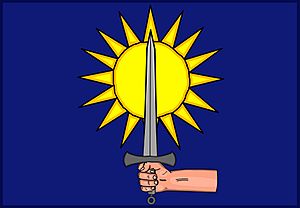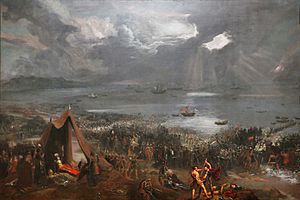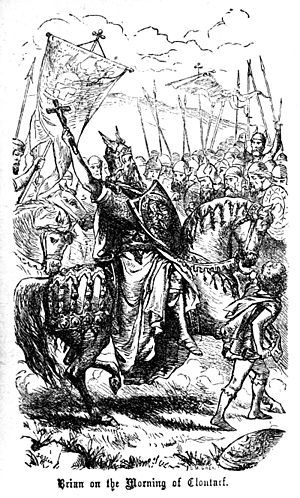Brian Boru facts for kids
Quick facts for kids Brian Boru |
|
|---|---|
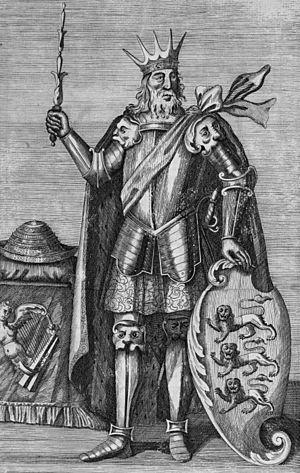
One of the earliest depictions of Brian on the 1723 publication of Dermot O'Connor's translation of Foras Feasa ar Éirinn.
|
|
| High King of Ireland | |
| Reign | 1002 – 1014 |
| Predecessor | Máel Sechnaill mac Domnaill |
| Successor | Máel Sechnaill mac Domnaill (restored) |
| King of Munster | |
| Reign | 978–1014 |
| Predecessor | Máel Muad mac Brain |
| Successor | Dúngal mac Máelfothartaig Hua Donnchada |
| Born | c. 941 Kincora, Cill Dalua, Kingdom of Munster |
| Died | 23 April 1014 Cluain Tarbh, Kingdom of Leinster |
| Consort | Mór Echrad Gormflaith Dub Choblaig |
| Issue | Murchad Conchobar Flann Tadc Donnchad Domhnall Kerthialfad (adopted) Sadb Bé Binn Sláine |
| House | O'Brien |
| Father | Cennétig mac Lorcáin |
| Mother | Bé Binn inion Urchadh |
| Religion | Roman Catholic |
Brian Boru (born around 941, died April 23, 1014) was a powerful Irish king. He ended the long rule of the Uí Néill family as High King of Ireland. He also played a big part in stopping Viking attacks on Ireland.
Brian built on the success of his father, Cennétig mac Lorcain, and his older brother, Mathgamain. He first became the king of Munster. Then he took control of Leinster. Eventually, he became the High King of all Ireland. Brian started the O'Brien family line. Many people see him as one of the most successful and unifying leaders in medieval Ireland.
Ireland at that time had many small kingdoms and over 150 kings. In 1002, the Uí Néill king, Máel Sechnaill mac Domnaill, agreed that Brian should be High King. This happened in Athlone. For the next ten years, Brian fought against kings who did not accept his rule. This included the northern Uí Néill and the people of Leinster. He also fought the Norse-Gaelic kingdom of Dublin. Old records called Brian "High King of the Gaels of Ireland and the Norse foreigners and the Britons". He was even called "Augustus of all north-western Europe." No other Irish king received such a grand title.
Brian's rule was seriously challenged in 1013. His ally Máel Sechnaill was attacked by the king of Cenél nEógain. Then, Norsemen from Dublin and people from Leinster attacked Máel Sechnaill. Brian fought these enemies in 1013. In 1014, his armies met the armies of Leinster and Dublin in a big battle. This was the famous Battle of Clontarf. Brian was killed during the battle. However, his army won against the Leinstermen and Norsemen. This battle is a very important part of Irish history.
Brian was well-respected by writers of his time. The Norse-Gaels and Scandinavians also wrote about him. These writings include Njal's Saga and Orkneyinga Saga. Brian's fight against Máel Mórda and Sigtrygg was linked to his marriages. He was married to Gormflaith. She was Máel Mórda's sister and Sigtrygg's mother. She had also been married to other kings before Brian.
Contents
Brian's Early Life
Brian Boru was one of twelve sons of Cennétig mac Lorcáin. Cennétig was the King of Dál gCais and Thomond (modern County Clare). This was a smaller kingdom in northern Munster. Brian's mother was Bé Binn inion Urchadh. She was the daughter of a king from west Connacht.
Brian was born at Kincora, his father's home in Killaloe. His nickname "Boru" might come from "Béal Bóruma". This was a fort near Killaloe. Another idea is that "Bóruma" means "of the cattle tribute". This would show he was a powerful ruler.
As the youngest of twelve brothers, Brian was not expected to become king. When he was young, he went to a monastery to study. He learned Latin and Irish history at Innisfallen monastery. But when Brian was ten, his father was killed by Vikings from Limerick. Brian then returned home.
One story says Brian saw Vikings raid a Dál gCais fort. The fort was by the River Shannon. The Vikings sailed up the river to attack. Brian and his brothers were on a hill watching their cattle. They saw smoke and heard screams. They rushed down, but the Vikings had left. The town was burned and looted. Brian's mother and several brothers were killed. This event deeply affected Brian.
The River Shannon was an easy way for Vikings to raid. Brian's father and brother had used river forces too. This might have made Brian appreciate naval forces later on. When his father died, Brian's older brother Mathgamain became king. Brian and Mathgamain fought together in Munster. When Mathgamain was killed in 976, Brian took his place. He then became king of all Munster.
Mathgamain's Rule and Viking Fights
In 964, Brian's brother Mathgamain took control of Munster. He captured the Rock of Cashel, the old capital. The traditional rulers of Munster, the Eóganachta, had become weak. This allowed Mathgamain's family, the Dál Cais, to try and become provincial kings. Mathgamain faced opposition from Máel Muad mac Brain and the Norse king Ivar of Limerick.
Mathgamain first made peace with the Norse of Limerick. But Brian wanted revenge for his family killed by Vikings. He left with his followers and started a guerrilla war against the Vikings. They attacked Viking forts and patrols. Their attacks weakened the Vikings. Mathgamain was inspired by Brian's bravery. He decided to join Brian to drive the Vikings out of Limerick and Munster.
They gathered an army from all over Munster. They even included their former enemy, Máel Muad. They ambushed the Norse at the Battle of Sulcoit. After their victory, they looted and burned Limerick. They killed fighting men and enslaved others. This was a major battle for Brian.
This victory was not the end. Mathgamain was captured in 976 and killed by Máel Muad. Máel Muad then ruled as king of Cashel for two years.
Brian Becomes King of Munster
Even after Mathgamain's death, the Dál gCais remained strong. Brian became King of Thomond. He quickly showed he was a great military leader. In 977, he attacked and killed the weakened Ivar. Brian then wanted to remove all Vikings from Munster. Imar, a ruler loyal to Ivar, fled to a monastery on Inis Cathaigh (Scattery Island). Brian attacked the island, killed the Vikings, and damaged the church. This was his revenge.
Around 978, Brian challenged Máel Muad to battle. He defeated him at the Battle of Belach Lechta. Máel Muad was killed. After this, the Eóganachta could no longer claim the kingship. So, Brian and the Dál gCais became the rulers of Munster.
The last opposition in Munster was an alliance. It included Irish rebels led by Donnubán, who killed Mathgamain. It also included the remaining Viking forces. Brian attacked them at the Battle of Cathair Cuan. He killed Donnubán and secured his power in Munster.
Brian allowed some Norse to stay in their settlement. They were wealthy and important for trade. They also had a valuable fleet of ships. Brian would use these ships in his later naval campaigns. Cian, the son of Máel Muad, later became Brian's loyal ally. He fought with Brian in many battles.
Brian and the High King
After becoming the undisputed ruler of Munster, Brian wanted to expand his power. He looked to the nearby provinces of Leinster and Connacht. This brought him into conflict with the High King, Máel Sechnaill mac Domnaill. Máel Sechnaill's power was based in the Province of Meath.
For fifteen years, from 982 to 997, Máel Sechnaill led armies into Leinster and Munster. Brian used his naval forces, about three hundred ships. He sailed up the Shannon River to attack Connacht and Meath. He faced some defeats but learned from them. Brian developed a strategy using both land and water forces. His naval forces, including ships from the Norse cities he controlled, helped his army. They could create diversions or attack from two sides.
The conflict started in 982. Brian was fighting in kingdom of Osraige. Máel Sechnaill attacked Munster while it was undefended. He destroyed the sacred tree of Adair, where Dál gCais chiefs were crowned. Brian responded by raiding Westmeath. Brian's fleet also attacked Connacht, but suffered losses. Máel Sechnaill then attacked Munster, killing many Dál gCais men.
There was a period of peace for about nine years. Brian continued to expand his power in the south and east. In 993, Brian controlled much of Munster and gained ground in Leinster. He used his naval power to attack Máel Sechnaill. His fleet sailed up the Shannon and invaded the Kingdom of Breifne. This put pressure on the High King from both north and south.
In 996, Brian finally controlled Leinster. This led Máel Sechnaill to make a deal with him in 997. They met at Bleanphottogue. Máel Sechnaill accepted Brian's rule over Leth Moga (the Southern Half). This included Munster, Leinster, and the Norse cities. Máel Sechnaill kept control of Leth Cuinn (the Northern Half). This included Meath, Connacht, and Ulster.
Because he had submitted to Brian, the king of Leinster was overthrown in 998. Máel Mórda mac Murchada replaced him. Máel Mórda rebelled against Brian. This rebellion threatened both Brian and Máel Sechnaill. So, they joined forces to defeat Leinster.
Brian gathered his armies from Munster. Máel Sechnaill gathered his from Meath. They planned to attack Dublin, ruled by Máel Mórda's ally, Sigtrygg Silkbeard. Máel Mórda and Sigtrygg decided to fight Brian's army directly. In 999, they fought the Battle of Glenmama. This was a very fierce battle. Brian won, and his army captured and looted Dublin.
Sigtrygg fled but found no help. He returned to Dublin and submitted to Brian. Brian chose to make peace. He asked Sigtrygg to return as ruler of Dublin. Brian also gave one of his daughters to Sigtrygg in marriage. Brian may have also married Sigtrygg's mother, Gormflaith, who was Máel Mórda's sister.
Brian Becomes High King
Brian's ambitions were not satisfied. In 1000, he led an army from Munster, Leinster, and Dublin to attack Máel Sechnaill's province of Meath. The fight for control of all Ireland began again. Máel Sechnaill's main ally was the king of Connacht. The Shannon River separated Meath and Connacht. Máel Sechnaill built two bridges across the Shannon. These bridges would block Brian's fleet and allow his allies to cross.
Records say that in 1002, Máel Sechnaill gave up his title to Brian. One story says Brian challenged Máel Sechnaill to a battle. Máel Sechnaill asked for a month to gather his forces. Brian agreed. But Máel Sechnaill could not gather enough support. So, he had to surrender his title to Brian. Historians debate this story. It seems unlikely Brian would give his enemy time to prepare. But it is generally accepted that Brian became the new High King of Ireland in 1002.
Brian's High Kingship
Brian, now in his 60s, spent the next decade securing his rule. He made the remaining smaller kingdoms accept his authority. He traveled around Ireland in 1005 and 1006. This showed his strength and energy, even at his age. Brian wanted to be a true High King, not just in name. He needed to control Ulster, the only province that did not fully accept him. The kingdoms of the northern Uí Néill and Ulaid were very powerful. It took Brian a lot of time and effort to bring them under his rule.
Ulster Campaigns
Ulster's geography made it hard to invade. There were only three main routes, and they favored the defenders. Brian had to get past these defenses. Then he had to defeat the independent kings of Ulster. It took Brian ten years of campaigning. He used all the military forces of the rest of Ireland. This shows how strong the Ulster kings were.
Brian received naval support from Sigtrygg Silkbeard of Dublin. Sigtrygg wanted revenge on the Ulaid. They had refused to help him after Brian forced him out of Dublin in 999.
Brian was also helped by a battle in 1003. This battle was between the Northern Uí Néill and the Ulaid. The king of the Cenél Eoghain was killed. Most of the Ulaid royal family was wiped out. This led to a bloody fight for power among the Ulaid. Brian accepted the submission of the Cenel Eoghain king in 1005. He later accepted the submission of many Ulaid clans.
However, Flaithbertach Ua Néill, the new king of the Northern Uí Néill, was rebellious. He continued to attack his neighbors. In 1005, after Brian left Ulster, Flaithbertach attacked the Ulaid. He killed several kings and princes and took hostages. This made Brian return in 1006 and 1007. In 1007, Brian took the Ulaid hostages from Flaithbertach. Flaithbertach submitted again and married one of Brian's daughters, Bé Binn.
Flaithbertach continued to cause trouble. In 1009, he attacked the king of the Cenél Chonaill. He also raided the Midlands. Brian returned to Ulster again. This time, he took hostages from the Cenél Eoghain. This finally made Flaithbertach truly submit.
Flaithbertach then joined Brian's sons in campaigns against the Cenél Chonaill in 1011. They were not successful. Brian then led a second invasion himself that year. He finally brought the Cenél Chonaill under his rule. Flaithbertach continued some attacks in 1011 and 1012. But he was no longer a threat to Brian.
Throughout these campaigns, Brian used his land and sea forces together. Ulster rulers could stop his army on land. But they could not stop his fleet from attacking their coasts. Brian defeated each ruler who defied him. He forced them to accept him as their overlord.
Brian also worked with the Church. The Church in Ireland was centered around monasteries. Armagh, in Ulster, was one of the most important. Brian's advisor, Maelsuthain O'Carroll, wrote that Brian gave 22 ounces of gold to Armagh in 1005. Brian declared Armagh the religious capital of Ireland. All other monasteries should send money there. This was a smart move. Armagh would support Brian as High King.
In the 'Book of Armagh', Brian is called "Imperator Scotorum" or "Emperor of the Gaels." This was a very important title. Some historians think Brian and the Church wanted to create a new kind of kingship. One with a single king ruling all of Ireland, like in England and France. By 1011, all regional rulers in Ireland accepted Brian's authority. But this peace did not last long.
Rebellion in Leinster
Máel Mórda mac Murchada of Leinster had accepted Brian's rule unwillingly. In 1012, he rebelled. One story says Brian's son insulted Máel Mórda. This made him declare independence and attack his neighbors.
Another reason might be that the kings of Leinster and Dublin thought Máel Sechnaill was weak. Flaithbertach Ua Néill of Ulster was causing trouble for Brian again. In 1013, he raided the Midlands. This brought him into conflict with Máel Sechnaill. Máel Sechnaill retreated from a standoff. This made Leinster think Meath was vulnerable. This would also weaken Brian.
Máel Mórda sought allies to defy Brian. He found one in Flaithbertach Uí Neill. Together, they attacked Meath. Máel Sechnaill asked Brian for help.
In 1013, Brian led forces from Munster and southern Connacht into Leinster. A part of his army, led by his son Murchad, raided southern Leinster for three months. Brian and Murchad's forces met outside Dublin on September 9. Brian's fleet blocked the city. But Brian's army ran out of supplies. So, Brian had to stop the siege and return to Munster around Christmas.
Battle of Clontarf
Máel Mórda knew Brian would return to Dublin in 1014. He hoped other rulers would join him. But most of Connacht and Ulster did not support either side. Only Flaithbertach Ua Néill sent troops to Máel Mórda. Máel Mórda then sought help from outside Ireland. He sent his nephew, Sigtrygg, to get support.
Sigtrygg sailed to Orkney and the Isle of Man. These islands had Viking settlements. The Norsemen from these islands were paid to fight. Some historians argue this was not a Viking attempt to conquer Ireland. All the Norsemen fought for Máel Mórda. Brian also had "Vikings" in his army. These were Hiberno-Norse from Limerick, Waterford, Wexford, and Cork. Some sources even mention a rival group of Norse mercenaries fighting for Brian. This suggests the conflict was more like an Irish civil war with some foreign help. However, recent research using network analysis of old texts suggests the traditional view of a war between Irish and Norsemen might be more accurate.
Brian gathered troops from Munster, southern Connacht, and Meath. Máel Sechnaill led the Meath group. Brian's army might have been larger. Brian sent his youngest son, Donnchad, to raid southern Leinster. He hoped this would force Máel Mórda's troops to leave the main battle.
Brian was also joined by Óspak, a Norseman. Óspak and his brother Brodir initially sailed to fight against Brian. But after a disagreement, Óspak left and joined Brian. He converted to Christianity and fought against his brother.
Brian and Máel Sechnaill's forces burned and looted the area north of Clontarf. But in one raid, Máel Sechnaill's son was killed. Over 150 Irish were killed in this ambush.
A disagreement between Brian and Máel Sechnaill led Máel Sechnaill to withdraw his support. Brian sent for Donnchad, but it was too late. Máel Mórda's Norse allies arrived on April 18. The battle happened five days later, on April 23, 1014. It was just north of Dublin, at Clontarf.
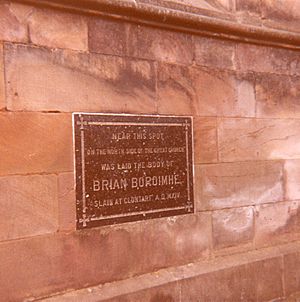
All accounts say the Battle of Clontarf lasted all day. The fighting was very bloody. Brian's army broke the enemy line. The Vikings tried to flee to their ships in the bay. But the tide came in. Many drowned as the Irish pursued them. Brian's army won partly because they had more soldiers. They also used small spears they threw at the enemy. Some accounts say Máel Sechnaill returned late to the battle. After Brian's death, he led the Irish army to complete the victory.
Many Irish royal family members were killed. Brian's son and heir, Murchad, died. He is said to have killed over 100 enemies. Brian's grandson, Toirdelbach, also died. He was 15 and drowned while pursuing the Vikings.
On the Leinster and Viking side, many were killed too. Máel Mórda died in the fighting. Sigurd the Stout of Orkney was killed by Murchad. Brodir, who likely killed Brian, was captured and executed.
Brian's Death
There are different stories about how Brian died. Some say he died fighting heroically. Others say he was too old and frail to fight. The most common story is that Brian was killed by the fleeing Viking mercenary Brodir. Brian was praying in his tent at Clontarf when this happened.
After his death on April 23, 1014, Brian's body was taken to Swords. Then it was taken to Armagh to be buried. His tomb is said to be in the north wall of St Patrick's Cathedral in Armagh.
Brodir was later captured and executed by Ulf the Quarrelsome. Ulf was an ally of Brian. Brodir's stomach was cut open, and he was made to walk around a tree. This caused his insides to wrap around the tree.
Brian was succeeded as High King by his former enemy and later ally, Máel Sechnaill mac Domnaill. Máel Sechnaill ruled until his death in 1022.
Brian's Legacy
For centuries, historians have debated Brian Boru and the Battle of Clontarf. The popular view is that the battle ended Viking power in Ireland. It is seen as a war between the Irish and Vikings. However, some historians see it as an Irish civil war. They argue that Brian's Munster and its allies defeated Leinster and Dublin. They point out that Vikings fought on both sides. Recent research using network analysis of old texts suggests the traditional view is largely correct. But it also shows the situation was more complex than a simple Irish versus Viking conflict.
The idea of Brian as the ruler who united Ireland to free it from Vikings comes from an old book. This book, Cogadh Gaedhil re Gallaibh ("The War of the Gaels with the Foreigners"), was likely written to support Brian's family's claim to the High Kingship.
While Ireland was never fully conquered by Vikings, Brian's rule involved constant conflict with them. Viking raiders began attacking Ireland in the late 700s. In the mid-800s, they built fortified camps that became Ireland's first cities. These include Dublin, Limerick, Waterford, Wexford, and Cork. Over generations, some Norse converted to Christianity and mixed with the Irish. They adopted Irish language and customs. These people are called Hiberno-Norse.
These Hiberno-Norse cities often faced attacks from Irish rulers. Brian's father was likely killed by the Norse of Limerick. Brian himself died during a revolt supported by Viking leaders.
Brian's Family
Brian's first wife was Mór. She was the daughter of a king from Connacht. She was the mother of his sons Murchad, Conchobar, and Flann. Murchad's son, Toirdelbach, was killed at Clontarf with his father and grandfather.
Another wife, Echrad, was the mother of Brian's son Tadc. Tadc's son and grandson later became very powerful.
Brian's most famous marriage was to Gormflaith. She was Máel Mórda's sister. Their son was Donnchad. Donnchad ruled Munster for 40 years after Brian's death.
Brian had a sixth son, Domnall. He died before his father. Brian also had at least three daughters. Their mothers are not known. Sadb married Cian, the son of Brian's old enemy. Bé Binn married the northern Uí Néill king Flaithbertach. A third daughter, Sláine, married Brian's stepson Sigtrygg Silkbeard of Dublin.
He also had a foster-son named Kerthialfad.
Family Line
Brian's descendants are known as the Uí Briain (O'Brien) clan. This is where surnames like O'Brien come from. The "O'" part means "grandson or descendant of." The O'Briens became one of the most important families in Ireland.
Brian's great-great-granddaughter was Gwenllian ferch Gruffydd. She was a princess in Wales. She led a revolt in 1136 that was part of a bigger rebellion. The Barons Inchiquin also claim to be descendants of Brian Boru.
Cultural Impact
Books
Brian Boru and the Battle of Clontarf are mentioned in many books. James Joyce's Finnegans Wake (1939) has many references. The 1949 novel Silverlock describes Brian's death. Morgan Llewlyn's Lion of Ireland (1980) is a historical novel about his life. Donal O'Neill's Sons of Death (1988) is another historical novel about Brian. Frank Delaney's novel Ireland (2005) tells the story of his final battle. Robert E. Howard wrote two versions of the Battle of Clontarf in 1931.
Music
Brian's name is in one of Ireland's oldest traditional tunes: "Brian Boru's March". It is still widely played by Irish musicians. He was also the subject of at least two operas. His burial is mentioned in the song "Boys from the County Armagh." The Irish folk metal band Cruachan has a song inspired by his battles called Born for War (The Rise of Brian Boru).
See also
 In Spanish: Brian Boru para niños
In Spanish: Brian Boru para niños
- Annals of Tigernach
- Annals of Ulster
- History of Ireland (800–1169)
- History of Ireland
- Lists of Irish kings
- List of High Kings of Ireland
|


